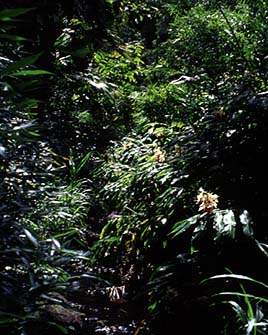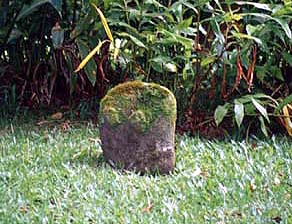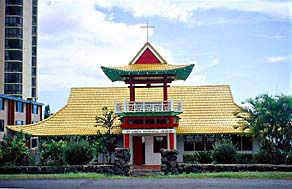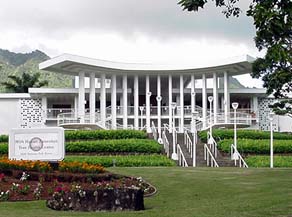 |
 |
 |
|||||||||||||||||||||
|
|
|
|
|
|
|
|
|
||||||||||||||||
|
|
|||||||||||||||||||||||
"Nu‘uanu has escaped the growth that has taken place on the Windward side -- the homes and all the subdivision development there," Kalani observes. "I guess we were lucky enough to escape it here because no developers were able to get a large plot of land. On the windward side, they bought them from large ranch owners that had kept them, or a plantation that might have had some, and so developers were able to buy up large acreages to open up subdivisions. But that wasn’t possible here, because the land had already been carved up and staked out by certain families earlier on. And if it was their intention to keep growth away, then I’ll have to thank them for it. Because it did work that way."
|
||
|
|
||
|
Nu‘uanu is attractive to newcomers, due to its easy accessibility from the Pali Highway, and the wide expanses of forest and conservation land that invite explorers. "The new people who say 'Let’s go explore the area,' then actually invade, because they don’t know anything. "At one time, I think probably people would go in and hide their marijuana patch, and that seemed to be a common thing to do on all the islands. And then we’d hear the gunfire—in this valley, it will reverberate. But I don’t think it goes on too much now, because I think the bow-and-arrow hunters have discovered them, and also because there are more law enforcement people. "Other newcomers go into the forest looking for bamboo shoots or something, and they will just run rampant through the forest, stomp all over everything, dig up, cut down. That’s a major impact. So we don’t want these people coming in -- don’t make a parking space, don’t let them through."
|
Forest trail in the Luakaha area.
|
|
|
The archaeological heritage in the valley also comes under threat. "For those who know, they will go in and start hunting for artifacts and things of value—which I find horrifying," Kalani adds, "because then they will rob and raid and ruin the site. So, many Hawaiians will not say exactly where a site is, or not say what is there. I say I don’t know because somebody will come along and steal from it. Right now that’s becoming a very severe problem. "That would be my concern, even with Pacific Worlds: will the people who look up this website be respectful of the area, and look for knowledge, and look for ways that would therefore guide their actions to be appropriate? Or will they look to find the ways that they can go in and exploit these places?"
|
|
|
|
|
"The stories from this area generally regard conducting oneself: they talk about how to do things, or how you conduct yourself in this place, and that’s what you could learn -- not to violate. Not to go and dig up something that doesn’t belong to you, or to go into somebody else’s kuleana or business. People like to tell stories about how something will happen to you -- you’re going to die if go up and turn over this stone over. Well, that’s not going to happen. You might die spiritually because you’ve gone out and repeatedly dug up heiau. Hawaiians would look at you and say, 'Well, you just don’t have any life at all, you poor thing, and you’re going to die on the vine.' "But such a person might say, 'I disagree with you; I’m going to be chief of the Smithsonian Institute, because I have all this stuff on my resume, and I’m going to have PhDs upon PhDs, and I’m going to be nifty-nifty.' "'Fine, fine.' The Hawaiians would sit here and say, 'and don’t forget to go soon.' Unfortunately that sort of man would have left in his wake the violation and destruction of many things, and other people would think that because he did it, they can do it. And the tolerant Hawaiian will grieve."
|
||
|
|
||
| Among the newer residents of Nu‘uanu today are many churches. Kalani suggests, "I think the churches thought why not? rather than because Nu‘uanu was a former site of Hawaiian religions. It is very quiet here, it's very spiritual. I don't know that it is a conscious thing of non-Hawaiians to move into this area because this area has a strong feeling of this. I am very aware of it, as a Hawaiian and human being. If others did too, I would be glad if they do, but I don’t know."
|
|
|
|
"Some of the churches also are former homes. Down just before you get to Wyllie, there’s the Unitarian Church. That was formerly was the Kamehameha Girls dormitory. Kamehameha Schools had run out of dorm space, so they acquired that property -- it was a big old home -- and they converted it into rooms for the seventh- and eighth-grade boarders. Then when they sold it, they sold it to the church, and the church converted it. "The Ah Fong house went down and became home to a Japanese sect, and now I think it’s called the Healing Center. Since the highway was cut through, they now sit at the entrance of Nu‘uanu Pali Drive."
|
|
|
|
|
"It seems that only Nu‘uanu and Manoa had the homes with property, that hadn’t been all cut up into little plots of land. That has been one thing that Nu‘uanu has retained. I think that is because the haole people that came early on -- the 'Oh boy, this is the place to be, let’s just scoop it up right now.' And the missionary descendents who did that, I think they wanted to keep it for themselves. But it worked out to the advantage of others who lived here. "Today we find that that ended up protecting Nu‘uanu. They didn’t want all those new hoi-polloi coming up here and getting in their way. They wanted to keep their stakes, and they could let the new people go to Kailua, or Kaimuki, or ‘Ewa, just as long as they didn’t come here and bother them. "So someone early on said, well, we don’t want to have all these postage-stamp-sized parcels, so let’s have zoning of half an acre or more. If it's smaller down the valley, it's that they’ve changed it, from that point on. But from here up, and as far as I know on Nu‘uanu Pali Drive, it remains half an acre."
|
||
|
|
||
|
Nonetheless, the transformation of Nu‘uanu into a residential suburb of downtown Honolulu has enormously affected the functioning of this area as an ahupua‘a.
|
||
|
|
||
| |
| |
|
|
 |
| Nu‘uanu Home | Map Library | Site Map | Hawaiian Islands Home | Pacific Worlds Home |
|
|
|||
| Copyright 2003 Pacific Worlds & Associates • Usage Policy • Webmaster |
|||









